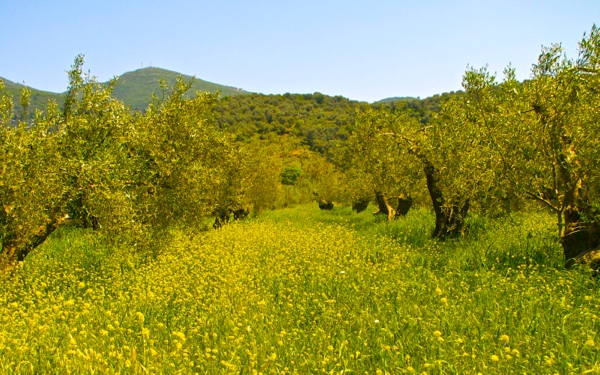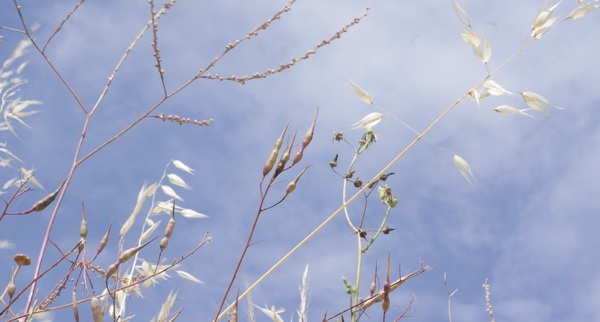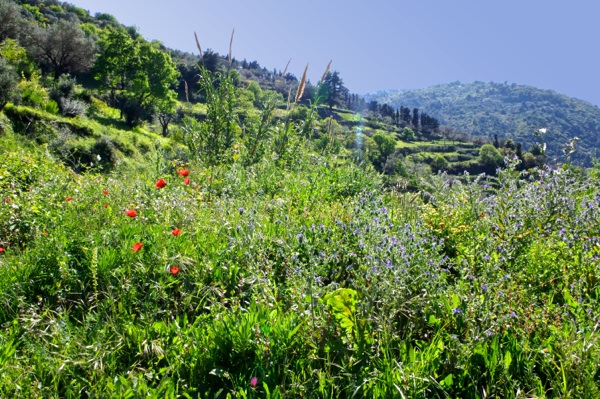The Wild Flowers of Skopelos
Blog
For those who love Skopelos and the wildflowers of Greece
The Wild Flowers of Skopelos
Blog
For those who love Skopelos and the wildflowers of Greece
Mustard, Cress and Vrouves
27 Dec 2020

At the dark time of year it is good to think of brighter times, bringing to mind the brilliant yellow of the fields in early summer, when they are filled with the flowers of mustard plants.
To most people the word mustard refers to a pungent yellow condiment, but to a botanist it is a group of plants belonging to the cabbage family, the Brassicaceae, although mustard is not a botanical term The plants are easily recognised, as they have divided, “mustard shaped” leaves and four petaled flowers, usually yellow. The family may also be called crucifiers or Crusiferae as the flower petals are arranged in the form of a cross. They are however often difficult to differentiate one from the other when flowering, though they can be identified by their fruits.

Several mustard plants grow on Skopelos with tall black mustard, Brassica nigra, growing along the roadside; white mustard, Sinapis alba, in fields and olive grove and bastard cabbage, Rupestrum rugosa, filling the fields with yellow flowers. Smaller mustards thrive on dry stony ground: Bunias erucago and Biscutella didyma both can be found in the vicinity Sendoukia and Cretan mustard, Brassica cretica survives clinging to the sea-cliffs. The plants can often be recognised by their curious seed pods.
The potency of mustard has been recognised since ancient times, when it was often used as medication, either in mixtues taken orally or as a local application. It is said that when Zarius met Alexander the Great prior to battle, Zarius gave Alexander a bag of sesame seed with one seed for every soldier in his army to indicating its huge size. Alexander returned a bag of mustard seeds, which, though fewer in number, illustrated how strong and ferocious his Greek soldiers were.
With its white flowers, water-cress (Nasturtium officinale), also belongs to the mustard family, it grows in the fresh water streams and can even be seen in the storm drain bordering the peripheral road.
Leaves of the brassicas are collected on Skopelos as horta and either cooked as boiled greens or eaten, when young, as picant salad leaves. All parts of the plants are edible and the flower buds are particularly prized and known as vrouves (βρούβες).
Some of the mustard plants growing on Skopelos:







The Plant Families of Skopelos
8 Oct 2020

An individual flower shares its name with other plants which look the same, the species. A species is a group of plants which share the same characteristics and can breed with each other to produce offspring with the same traits; a genus is a group of plants which share similar attributes, they are not the same but are closely related. The scientific name has two parts, a species name which follows the genus name.
A common daisy is called Bellis perennis and a wood daisy Bellis sylvestris.
Bellis is the genus name, perennis and sylvestris are species names.
Some genera are small and may contain only one species; the judas tree (Ceratonia siliqua), which is familiar on Skopelos as a beautiful tree with purple flowers and interesting seed pods, is the only species of the Ceratonia genus. Other genera have many species; the Silene genus has more than 900 species worldwide, with over 100 in Greece and at least ten different silenes on Skopelos.
There are hundreds of thousands of plant species in the world; a recent estimate totalled 391,000 and there are thousands of genera. These are further grouped into families, which have many similarities and genetic profiles; as with any living thing, plants of the same family share the same ancestry. The scientific names of plant familes all end with -acae, e.g. Orchidaceae, the orchid family, which is the most populous family worldwide; followed by the daisy family (Asteraceae). Other important families on Skopelos include: the pea family (Fabaceae), the carrot or parsley family (Apiaceae) and the mint family (Lamiaceae).
For the amateur botanists amongst you, the relationship of some of the flowers found on Skopelos is shown in the
and for a full list of families found on Skopelos go to the Family Index
or just enjoy looking at the flowers listed by colour.
For more on naming of flowers go to the About page.


















Now more than 300 flowers and trees

The Wildflowers of Skopelos is for those who love the island of Skopelos and the wildflowers of Greece.
There are now over 300 flowers and trees and also information on the island, its floral landscape, geology, climate, and ecological habitats.

















